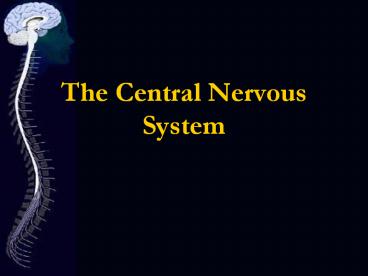The Central Nervous System - PowerPoint PPT Presentation
Title:
The Central Nervous System
Description:
The Central Nervous System ... viral or fungal infections. ... Hippocampus- found in the limbic system and associated with short term memory Amygdala- helps decode ... – PowerPoint PPT presentation
Number of Views:183
Avg rating:3.0/5.0
Title: The Central Nervous System
1
The Central Nervous System
2
CNS
3
Meninges of the Brain
- Dura Mater (HARD MOTHER) - outer layer, strong
white fibrous tissue. - Arachnoid membrane (SPIDER WEB) - middle layer,
cobweb like layer. - Pia Mater (SOFT MOTHER)-inner layer, adheres to
the brain, translucent.
4
Divisions of Meninges
- Falx cerebri- parts right and left cerebral
hemispheres - Sinuses within the dura function as venus
reservoirs - Pia mater contains blood vessels that surround
brain
Falx cerebri
Falx cerebri
5
Did you know?
- Menigitis- inflammation of the meniges caused by
bacteria, viral or fungal infections. - Subdural Hematoma- large blood clot found in
under the dura mater. Usually sign of trauma.
6
Cerebral Spinal fluid
- CSF- provides a cushion of protection around
brain spinal cord. - Ventricles- 4 fluid filled spaces in the brain.
- 1st 2nd (2 lateral), 3rd and 4th (very tiny)
- CSF is formed in the choroid plexuses then
circulated via the ventricles
7
Ventricles in the Brain
8
The Brain Stem
- Brain Stem(vital centers)
- Medulla Oblongata- controls heart rate, blood
pressure, breathing - Landmarks- olives pyramids
- Pons- helps control vital functions
9
The MidBrain
- Midbrain- connects brain stem and cerebrum via
the cerebral peduncles - Corpora quadrigemina (body of four twins) is
the inferior and superior colliculi. - Inferior colliculi functions as auditory
processing center. - Superior colliculi function as visual processing
center. - Red nucleus and substantia nigri(black matter)
function in motor control., secretes dopamine.
10
The Brain
- Cerebellum
- Controls skilled muscle movements, posture and
balance. - Is connected to thalamus and motor cortex areas
of the cerebrum.
11
Diencephalon between-brain
- Hypothalamus
- Connects info from nervous and endocrine to
maintain homeostatsis. - Regulates appetite and feelings of satisfaction.
- Mind-body link (psychosomatic affect).
- Temperature control site
12
Diencephalon
- Thalamus
- detects mild pain and temperature sensation
- determines whether something is pleasant
- Relays sensory info to cerebrum
- Optic chiasma- where optic nerve cross before
entering the brain - Pineal gland- secretes melatonin to regulate
sleep.
13
The Cerebrum
Gyrus (bulge)
Sulcus (crevice)
14
The Cerebrum
15
The Cerebrum
- Cerebrum
- Cerebral cortex- gray matter on the outside of
the cerebrum - Responsible for conscious thought
- Memory
- Awareness
- language
- reasoning.
16
Cerebral plasticity- regions can vary in their
functions between different individuals.
17
Regions of the Cerebrum
Corpus callosum
Cingulate gyrus
- Corpus Callosum-connects the right and left
hemispheres - Limbic system- controls emotions, anger, sorrow
and pleasure. - Hippocampus- found in the limbic system and
associated with short term memory - Amygdala- helps decode
Anterior thalamic nuclei
Hypothalamic nuceli
Fornix
Olfactory tract
Mammillary bodies
Amygdala
Parahippocampal gyrus
Hippocampus
18
Regions of the Cerebrum
- Reticular Activating system-when stimulated
causes consciousness - REM- rapid eye movement sleep, dreaming
- SWS- slow wave sleep, no dreaming
19
Image of Brain Homunculus
- little man represented in each hemisphere of
the brain, depicts amount of sensory receptors in
certain areas
20
Disorders of the Brain
- Stroke (Cerebrovascular accident CVA)
- Usually because of a clot there is a cessation of
blood to the brain and the region is starved of
oxygen. - Hemiplegia- paralysis on one side of the body.
- Huntington disease
- Involuntary movements, dementia and death
- Creutzfeldt-Jakob
- Human mad cow disease. A prion causes protein
denaturization in the brain. - Seizures
- sudden burst of neuron activity. Epilepsy is
chronic seizure, normally idiopathic.
21
The Spinal Cord
- Located within the spinal cavity along with the
meninges, cerebrospinal fluid, adipose tissue and
blood vessels
22
The Spinal Column
- Dorsal nerve root
- Carry sensory information to the spinal cord,
afferent pathways - Cell bodies of these unipolar neurons make up a
small area of gray matter called the dorsal root
ganglion - Ventral nerve root
- Carries motor information out of spinal cord,
efferent pathways - Cell bodies of these mulitpolar neurons compose
the inner core of gray matter - Spinal Nerve
- Dorsal and Ventral join together to form this
single nerve
23
The Spinal Cord
24
The Spinal Cord
- Ascending Tracts
- Conduct sensory impulses up to the brain
- Descending tracts
- Conduct motor impulses down from the brain
25
Nerve Repair
PNS
- Nerve damage caused by trauma can sometime be
repaired by regrowth of the axon - Neurons can never replicate themselves
- There is evidence that shows new neurons can grow
out of adult stem cells in the spinal cord
CNS
26
Spinal Cord Injuries































